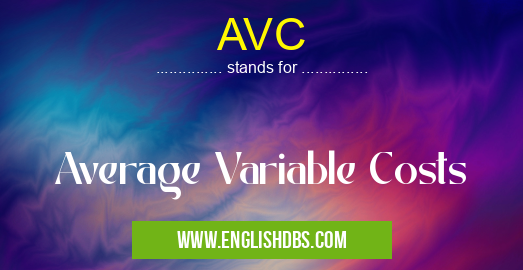What does AVC mean in ACCOUNTING
Average Variable Costs (AVC) refer to the cost associated with producing a single unit of an item or service by variable inputs. This cost does not include fixed costs such as rent, salaries, and other overhead costs. AVC is calculated by adding all variable costs incurred in the production process and dividing it by the total number of units produced. It is used in business decisions such as setting prices and analyzing production efficiency.

AVC meaning in Accounting in Business
AVC mostly used in an acronym Accounting in Category Business that means Average Variable Costs
Shorthand: AVC,
Full Form: Average Variable Costs
For more information of "Average Variable Costs", see the section below.
» Business » Accounting
Definition
AVC stands for Average Variable Costs, which represents the cost associated with producing a single unit of an item or service. This cost includes all variable input costs, such as raw materials, labor, energy consumed, etc., but does not include any fixed costs like rent or salaries that are incurred regardless of production levels. AVC is calculated by taking into account all expenses associated with producing a single unit and dividing it by the total number of units produced.
Examples
AVC can be used to make business decisions such as setting prices or analyzing production efficiency. For example, if a company produces 1,000 widgets at a total cost of $10,000 and their AVC is $1 per widget, they can price each widget at $1+ to generate a profit on each sale. Additionally, companies can use AVC to compare different input sources to determine which one is more efficient or cost-effective for their product's needs.
Essential Questions and Answers on Average Variable Costs in "BUSINESS»ACCOUNTING"
What are average variable costs?
Average variable costs (AVCs) represent the amount of money spent for the production of a unit of output, including labor and raw material costs. Variable costs alter proportionally with changes in output, as opposed to fixed costs which stay constant regardless of production.
How do you calculate average variable cost?
To calculate average variable cost, you need to divide total variable cost by the quantity produced. For example, if your total variable cost was $1000 and you produced 50 units then your average variable cost would be $20 per unit ($1000/50).
How is average variable cost used in decision-making?
Average Variable Cost can be used to determining pricing strategies or setting product budgets. AVC helps inform whether raising prices or cutting costs will increase an organization's overall profits. It also helps identify areas where overhead may be cut without sacrificing quality or quantity of product offered.
What is marginal cost vs average variable cost?
Marginal Cost is the additional cost that arises from making one more unit of output and Average Variable Cost is the per-unit cost that includes all labor and material inputs required for production. Marginal Cost focuses only on changes in input costs while Average Variable Cost looks at total input costs over all units produced.
Are fixed costs different than average variable costs?
Yes, fixed costs are different than AVCs. Fixed costs remain constnat regardless of production levels while averyvariablecosts vary depending on how much is being produced or consumed.
What factors should businesses consider when analyzing their Average Variable Costs?
Businesses should take into account not only current AVCs but also potential future increases in input prices due to inflation, exchange rate fluctuations, currency devaluation, etc. They should also analyze any potential shift in demand for their products which might cause their current AVC structure to become unsustainable.
Is there any risk associated with managing average variable costs?
Yes, there is always a certain level of risk associated with managing AVCs - too many resources could be allocated inefficiently which could result in higher expenses or lower profits than desired. Additionally, reliance on just one supplier could lead to shortages if they cannot meet demand or unfavorable terms if they accuse monopoly power.
Is it possible to reduce average variable costs for a business?
Yes, reducing AVCs can help boost profitability for businesses by decreasing their expenses related to production activities such as materials and labour. This can be achieved through various methods such as better supply management, bulk discounts when purchasing inputs from suppliers, improved process efficiencies and automation.
: Why cannot all fixed expenses be converted intovariable ones?
Not all fixed expenses can be converted easily intovariable ones since some are necessary for continued operations even though there may not appear to be an immediate return on investment (ROI). Examples include rent payments, insurance premiums and interest payments
Final Words:
Average Variable Costs provide businesses with useful information about how their products are being produced and how much they should be charging for them in order to turn a profit. By understanding these costs and calculating them correctly businesses can better assess their production processes and pricing strategies so that they can maximize profits while providing quality products at competitive prices.
AVC also stands for: |
|
| All stands for AVC |
